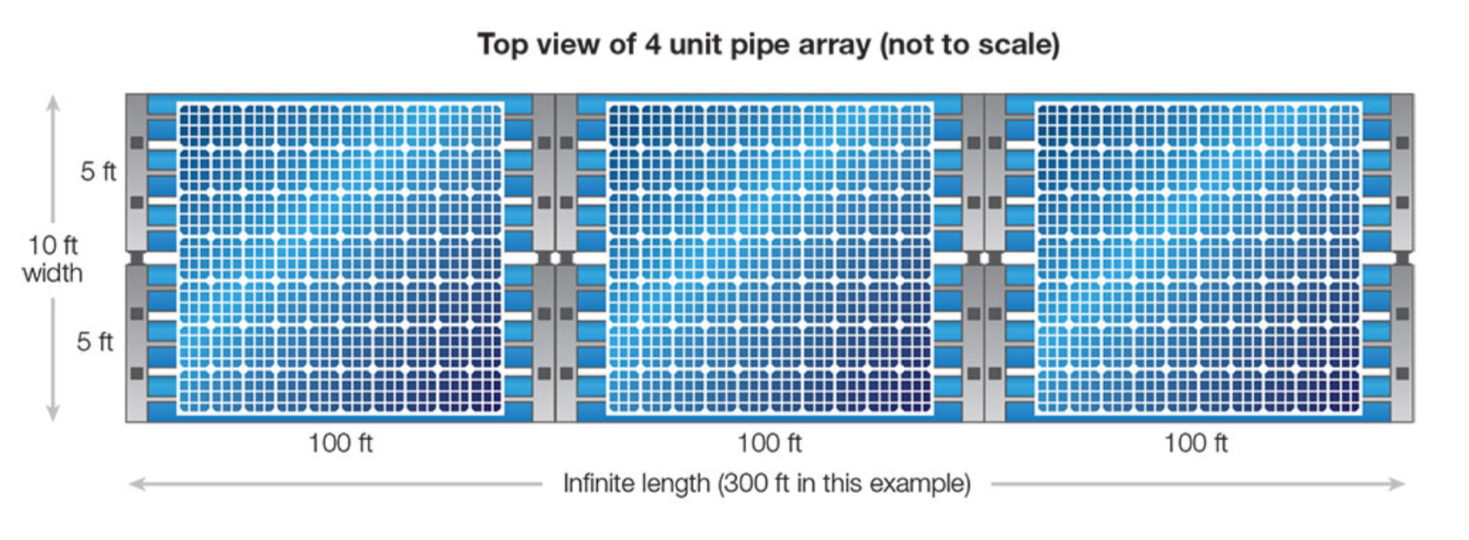The National Aqueduct is designed to transport an effectively unlimited amount of desalinated water from the coasts to anywhere inland. Powered by Scarcity Zero, it can deliver on that promise. But like many of the systems included within the framework, the National Aqueduct is not a one-trick pony. It has additional functions to generate electricity and to serve as a battery for renewable energy on a massive scale.
To consider a nationwide array of water pipelines a “battery” of any sort may seem strange – especially since “batteries” technically require a chemical reaction to facilitate an electric charge. But the National Aqueduct would have the same effect as a battery in function – far beyond that of the Bath County Pumped Storage Station in Northwest Virginia, a similar concept of pumped-storage hydroelectric power that remains the largest of its kind in the world (currently).[1]
By taking advantage of three aspects of the water transmission system – surface area for solar power, water flow for hydroelectric power, and water heat for thermoelectric power – we have a platform on which to build potent external electricity generation and storage systems.
Best of all, as with CHP Plants, these systems can work together in a cogenerative capacity, presenting additional benefits.
To explain how, we’ll go through each of these three aspects.
Surface area for solar panels. Scarcity Zero intends to deploy National Aqueduct pipelines at the side of highways or under currently existing long-distance power lines. That’s because this land is usually state-owned and doesn’t need to be purchased, and also because it’s pre-cleared of obstructions. If you recall from last chapter, water pipelines are designed to be installed in prefabricated arrays, which boast relatively flat surfaces. So, what if we were to cover their surface area with solar panels? The result, in the following image, is the final intended form of National Aqueduct pipeline arrays:

Across the thousands of miles such pipeline arrays would span, integrating them with solar panels stands to generate extremely high levels of electricity – far beyond any single power plant.[2] Alongside solar road networks and other municipally integrated renewables, they can also help reinforce a redundant, smart electric grid.
To see how, let's assume solar-enabled water transmission pipelines had a surface width of 10 feet. Multiplied by a mile, that's 52,800 square feet. Going back to our estimate of 30 kilowatt-hours annually generated per square foot, a one mile stretch of solar-integrated pipelines would generate 1.58 million kilowatt-hours per year – enough to power 150 homes. Keeping in mind that there are four million miles of road surfaces in the United States,[3] even fractional integration would be sufficient to power tens of millions of homes. Total integration, hypothetically, would annually generate 6.32 trillion kilowatt hours – nearly twice our annual national energy consumption. And that’s just from one of three power sources of the National Aqueduct.
Integration with wind turbines. Across the wide, open expanses of rural America, wind power is especially effective. Placement in close proximity with the National Aqueduct would enable a uniquely convenient source of transmission and storage for the electricity they generate, that like other municipal placement, avoids the need to buy expensive land.

Wind can assist the National Aqueduct in both electricity transmission and thermoelectric battery functions. During peak demand, wind turbines integrated throughout the National Aqueduct could directly power regional areas, as the Aqueduct itself would effectively be a nationwide electric grid that could transmit electricity at high efficiencies. Conversely, the energy they generate could be diverted to water heating elements that keep the Aqueduct’s battery function at maximum capacity. As the Aqueduct is a “smart” system that operates within a modular, responsive framework, it would be able to respond to these needs intelligently, making wind integration yet another force multiplier to the National Aqueduct’s already multifaceted capabilities.